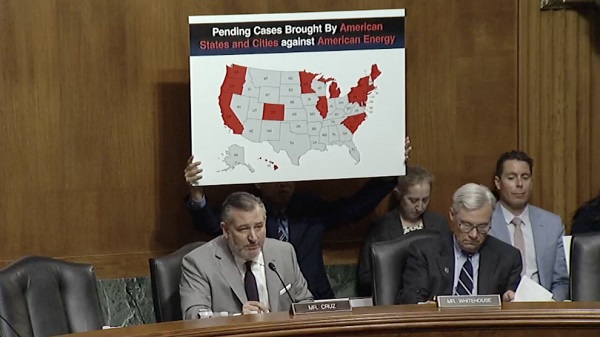Energy
Why Canada Must Double Down on Energy Production

From the Frontier Centre for Public Policy
By Lee Harding
Must we cancel fossil fuels to save the earth? No.
James Warren, adjunct professor of environmental sociology at the University of Regina said so in a recent paper for the Johnson Shoyama School of Public Policy, a joint effort by his university and the University of Saskatchewan. The title says it all: “Maximizing Canadian oil production and exports over the medium-term could help reduce CO2 emissions for the long-term.”
The professor admits on the face of it, his argument sounds like a “drink your way to sobriety solution.” However, he does make the defensible and factual case, pointing to Canadian oil reserves and a Scandinavian example.
Decades ago, Norway imitated the 1970’s Heritage Fund in Alberta that set aside a designated portion of the government’s petroleum revenues for an investment fund. Unlike Alberta, Norway stuck to that approach. Today, those investments are being used to develop clean energy and offer incentives to buy electric vehicles.
Norway’s two largest oil companies, Aker BP and Equinor ASA have committed $19 billion USD to develop fields in the North and Norwegian Seas. They argue that without this production, Norway would never be able to afford a green transition.
The same could be said for Canada. Warren laid out stats since 2010 that showed Canada’s oil exports contribute an average of 4.7% of the national GDP. Yet, this noteworthy amount is not nearly what it could be.
Had Trans Mountain, Northern Gateway, and Energy East pipelines been up and running at full capacity from 2015 to 2022, Warren estimates Canada would have seen $292 billion Canadian in additional export revenues. Onerous regulations, not diminished demand, are responsible for Canada’s squandered opportunities, Warren argues this must change.
So much more could be said. Southeast Asia still relies heavily on coal-fired power for its emerging industrialization, a source with twice the carbon emission intensity as natural gas. If lower global emissions are the goal, Canadian oil and natural gas exports offer less carbon-intensive options.
China’s greenhouse gas emissions (GHGs) are more than four times what they were in 1990, during which the U.S. has seen its emissions drop. By now, China is responsible for 30% of global emissions, and the U.S. just 11%. Nevertheless, China built 95% of the world’s new coal-fired power plants in 2023. It aims for carbon neutrality by 2060, not 2050, like the rest of the world.
As of 2023, Canada contributes 1.4 percent of global GHGs, the tenth most in the world and the 15th highest per capita. Given its development and resource-based economy, this should be viewed as an impressively low amount, all spread out over a geographically diverse area and cold climate.
This stat also reveals a glaring reality: if Canada was destroyed, and every animal and human died, all industry and vehicles stopped, and every furnace and fire ceased to burn, 98.6% of global greenhouse gas emissions would remain. So for whom, or to what end, should Canada kneecap its energy production and the industry it fuels?
The only ones served by a world of minimal production is a global aristocracy whose hegemony would no longer be threatened by the accumulated wealth and influence of a growing middle class. That aristocracy is the real beneficiary of prevailing climate change narratives on what is happening in our weather, why it is happening, and how best to handle it.
Remember, another warming period occurred 1000 years ago. The Medieval Warming Period took place between 750 and 1350 AD and was warmest from 950 to 1045, affecting Europe, North America, and the North Atlantic. By some estimates, average summer temperatures in England and Central Europe were 0.7-1.4 degrees higher than now.
Was that warming due to SUVs or other man-made activity? No. Did that world collapse in a series of floods, fires, earthquakes, and hurricanes? No, not in Europe at least. Crop yields grew, new cities emerged, alpine tree lines rose, and the European population more than doubled.
If the world warms again, Canada could be a big winner. In May of 2018, Nature.com published a study by Chinese and Canadian academics entitled, Northward shift of the agricultural climate zone under 21st-Century global climate change. If the band of land useful for crops shifts north, Canada would get an additional 3.1 million square kilometers of farmland by 2099.
Other computer models suggest warming temperatures would cause damaging weather. Their accuracy is debatable, but even if we concede their claims, it does not follow that energy production should drop. We would need more resilient housing to handle the storms and we cannot afford them without a robust economy powered by robust energy production. Solar, wind, and geothermal only go so far.
Whether temperatures are warming or not, Canada should continue tapping into the resources she is blessed with. Wealth is a helpful shelter in the storms of life and is no different for the storms of the planet. Canada is sitting on abundant energy and should not let dubious arguments hold back their development.
Lee Harding is Research Fellow for the Frontier Centre for Public Policy.
Energy
China undermining American energy independence, report says

From The Center Square
By
The Chinese Communist Party is exploiting the left’s green energy movement to hurt American energy independence, according to a new report from State Armor.
Michael Lucci, founder and CEO of State Armor, says the report shows how Energy Foundation China funds green energy initiatives that make America more reliant on China, especially on technology with known vulnerabilities.
“Our report exposes how Energy Foundation China functions not as an independent nonprofit, but as a vehicle advancing the strategic interests of the Chinese Communist Party by funding U.S. green energy initiatives to shift American supply chains toward Beijing and undermine our energy security,” Lucci said in a statement before the Senate Judiciary Subcommittee’s hearing on Wednesday titled “Enter the Dragon – China and the Left’s Lawfare Against American Energy Dominance.”
Lucci said the group’s operations represent a textbook example of Chinese influence in America.
“This is a very good example of how the Chinese Communist Party operates influence operations within the United States. I would actually describe it as a perfect case study from their perspective,” he told The Center Square in a phone interview. “They’re using American money to leverage American policy changes that make the American energy grid dependent upon China.”
Lucci said one of the most concerning findings is that China-backed technology entering the U.S. power grid includes components with “undisclosed back doors” – posing a direct threat to the power grid.
“These are not actually green tech technologies. They’re red technologies,” he said. “We are finding – and this is open-source news reporting – they have undisclosed back doors in them. They’re described in a Reuters article as rogue communication devices… another way to describe that is kill switches.”
Lucci said China exploits American political divisions on energy policy to insert these technologies under the guise of environmental progress.
“Yes, and it’s very crafty,” he said. “We are not addressing the fact that these green technologies are red. Technologies controlled by the Communist Party of China should be out of the question.”
Although Lucci sees a future for carbon-free energy sources in the United States – particularly nuclear and solar energy – he doesn’t think the country should use technology from a foreign adversary to do it.
“It cannot be Chinese solar inverters that are reported in Reuters six weeks ago as having undisclosed back doors,” he said. “It cannot be Chinese batteries going into the grid … that allow them to sabotage our grid.”
Lucci said energy is a national security issue, and the United States is in a far better position to achieve energy independence than China.
“We are luckily endowed with energy independence if we choose to have it. China is not endowed with that luxury,” he said. “They’re poor in natural resources. We’re very well endowed – one of the best – with natural resources for energy production.”
He said that’s why China continues to build coal plants – and some of that coal comes from Australia – while pushing the United States to use solar energy.
“It’s very foolish of us to just make ourselves dependent on their technologies that we don’t need, and which are coming with embedded back doors that give them actual control over our energy grid,” he said.
Lucci says lawmakers at both the state and federal levels need to respond to this threat quickly.
“The executive branch should look at whether Energy Foundation China is operating as an unregistered foreign agent,” he said. “State attorneys general should be looking at these back doors that are going into our power grid – undisclosed back doors. That’s consumer fraud. That’s a deceptive trade practice.”
Energy
Carney’s Bill C-5 will likely make things worse—not better

From the Fraser Institute
By Niels Veldhuis and Jason Clemens
The Carney government’s signature legislation in its first post-election session of Parliament—Bill C-5, known as the Building Canada Act—recently passed the Senate for final approval, and is now law. It gives the government unprecedented powers and will likely make Canada even less attractive to investment than it is now, making a bad situation even worse.
Over the past 10 years, Canada has increasingly become known as a country that is un-investable, where it’s nearly impossible to get large and important projects, from pipelines to mines, approved. Even simple single-site redevelopment projects can take a decade to receive rezoning approval. It’s one of the primary reasons why Canada has experienced a mass exodus of investment capital, some $387 billion from 2015 to 2023. And from 2014 to 2023, the latest year of comparable data, investment per worker (excluding residential construction and adjusted for inflation) dropped by 19.3 per cent, from $20,310 to $16,386 (in 2017 dollars).
In theory, Bill C-5 will help speed up the approval process for projects deemed to be in the “national interest.” But the cabinet (and in practical terms, the prime minister) will determine the “national interest,” not the private sector. The bill also allows the cabinet to override existing laws, regulations and guidelines to facilitate investment and the building of projects such as pipelines, mines and power transmission lines. At a time when Canada is known for not being able to get large projects done, many are applauding this new approach, and indeed the bill passed with the support of the Opposition Conservatives.
But basically, it will allow the cabinet to go around nearly every existing hurdle impeding or preventing large project developments, and the list of hurdles is extensive: Bill C-69 (which governs the approval process for large infrastructure projects including pipelines), Bill C-48 (which effectively bans oil tankers off the west coast), the federal cap on greenhouse gas emissions for only the oil and gas sector (which effectively means a cap or even reductions in production), a quasi carbon tax on fuel (called the Clean Fuels Standard), and so on.
Bill C-5 will not change any of these problematic laws and regulations. It simply will allow the cabinet to choose when and where they’re applied. This is cronyism at its worst and opens up the Carney government to significant risks of favouritism and even corruption.
Consider firms interested in pursuing large projects. If the bill becomes the law of the land, there won’t be a new, better and more transparent process to follow that improves the general economic environment for all entrepreneurs and businesses. Instead, there will be a cabinet (i.e. politicians) with new extraordinary powers that firms can lobby to convince that their project is in the “national interest.”
Indeed, according to some reports, some senators are referring to Bill C-5 as the “trust me” law, meaning that because there aren’t enough details and guardrails within the legislation, senators who vote in favour are effectively “trusting” Prime Minister Carney and his cabinet to do the right thing, effectively and consistently over time.
Consider the ambiguity in the legislation and how it empowers discretionary decisions by the cabinet. According to the legislation, cabinet “may consider any factor” it “considers relevant, including the extent to which the project can… strengthen Canada’s autonomy, resilience and security” or “provide economic benefits to Canada” or “advance the interests of Indigenous peoples” or “contribute to clean growth and to meeting Canada’s objectives with respect to climate change.”
With this type of “criteria,” nearly anything cabinet or the prime minister can dream up could be deemed in the “national interest” and therefore provide the prime minister with unprecedented and near unilateral powers.
In the preamble to the legislation, the government said it wants an accelerated approval process, which “enhances regulatory certainty and investor confidence.” In all likelihood, Bill C-5 will do the opposite. It will put more power in the hands of a very few in government, lead to cronyism, risks outright corruption, and make Canada even less attractive to investment.
-

 Automotive1 day ago
Automotive1 day agoElectric vehicle sales are falling hard in BC, and it is time to recognize reality.
-

 Alberta5 hours ago
Alberta5 hours agoAlberta Independence Seekers Take First Step: Citizen Initiative Application Approved, Notice of Initiative Petition Issued
-

 Automotive1 day ago
Automotive1 day agoPower Struggle: Electric vehicles and reality
-

 Business1 day ago
Business1 day agoTrump on Canada tariff deadline: ‘We can do whatever we want’
-

 Business7 hours ago
Business7 hours agoCanada Caves: Carney ditches digital services tax after criticism from Trump
-

 Brownstone Institute2 days ago
Brownstone Institute2 days agoFDA Exposed: Hundreds of Drugs Approved without Proof They Work
-

 Crime7 hours ago
Crime7 hours agoSuspected ambush leaves two firefighters dead in Idaho
-

 Energy1 day ago
Energy1 day agoChina undermining American energy independence, report says



